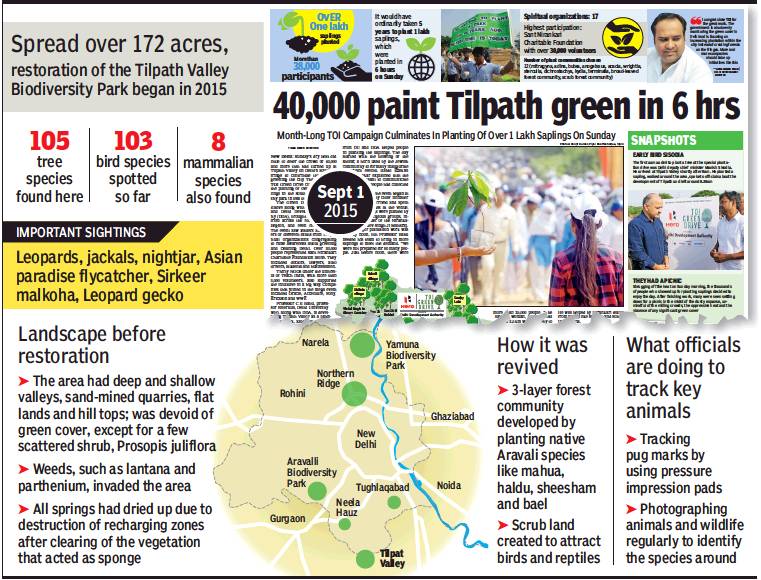Delhi: Tilpath Valley Biodiversity Park
This is a collection of articles archived for the excellence of their content. |
Revival
2018
Two years on, Tilpath breathes again, February 23, 2018: The Times of India

From: Two years on, Tilpath breathes again, February 23, 2018: The Times of India
Nearly two years after a revival project was taken up, the once barren Tilpath Valley Biodiversity Park now dons a lush green look.
Inaugurated in January 2018 by lieutenant governor Anil Baijal, the valley is open to all interested in nature and wildlife. Scientists said that over the past two years, a number of jackals, rare birds and even leopards had been spotted by locals.
Faiyaz Khudsar, the scientist in charge of Yamuna Biodiversity Park, said the change in landscape and ecology had brought back a number of species, including leopards and jackals.
Khudsar, who also worked on the revival project, said animals were being mapped and tracked through pressure impression pads (PIP) set up to keep track of species arriving each month. “The park is close to Tughlaqabad and Asola Bhatti Wildlife Sanctuary where leopard pugmarks have been spotted in the past. It is possible that the animal had come from there.”
Using PIPs, it has been found that large numbers of jackals, mongooses and porcupines have visited the area. “The prey base is building in the form of nilgai, and chances are that predators like leopards will come again,” said Khudsar. However, no recent pugmark has been spotted, he added.
When the revival work began, the landscape was devoid of vegetation, barring a few trees of prosopis juliflora, known to reduce groundwater levels. Weeds such as lantana and parthenium had also invaded the area.
Through a series of plantation campaigns by both Delhi Development Authority and TOI as part of Hero-TOI Green Drive in 2015, over one lakh native saplings were planted, which have already grown 6-8 feet, scientists said. In 2016, TOI planted 20,000 more plants as part of the drive.
“A three-storey canopy has been developed at the valley and all native species have been used. The area has been completely revived and birds, butterflies and reptiles have all come back,” said C R Babu, the professor emeritus and head of Centre for Environmental Management of Degraded Ecosystems who was also the chief ecologist of the project. At present, there are 115 plant, 103 bird, 32 butterfly, 15 reptile and amphibian, and eight mammalian species in the park.
As in 2021
Priyangi Agarwal, February 18, 2021: The Times of India

From: Priyangi Agarwal, February 18, 2021: The Times of India
Forest officials are attempting to repopulate the Tilpath Valley Biodiversity Park, which was inaugurated in February 2018, with animal species. The focus is on chital deer and chinkara gazelle in the first phase.
The biodiversity grassland was developed as a food base for herbivores. For a similar purpose, water bodies were created there. Park officials said they are in touch with the forest department of Madhya Pradesh for translocation of animals. They said they were also hopeful that natural migration of herbivores would take place from the Aravali in Haryana and Asola Bhatti Wildlife Sanctuary because Tilpath Valley shares a border with both.
The presence of many reptilian species like Indian cobra, Indian rock python and Pakistani ribbon snake and mammals, including nilgai, jackal, Indian hare and porcupine, have been recorded in the biodiversity park. However, the authorities said they plan to ecologically diversify the park by introducing herbivores there. “After bringing deer family species like chital and chinkara, we may later diversify and include other cervidae like hog deer, for which we need a specialised grassland,” said C R Babu, professor emeritus and head of the Centre for Environmental Management of Degraded Ecosystem, Delhi University.
According to park officials, a natural ecosystem has herbivores, primary carnivores such as civet cats and secondary carnivores such as leopard and hyenas. The park does have civet cats, and though villagers have spotted a leopard and hyenas in the past, it is believed that they strayed into the area briefly from the Aravalis. “When herbivores are present in the park, the carnivores will be attracted. For animals like leopards, we need effective protection, which will be created in the future,” said an official.
The park authorities said they would not source animals from the zoo as captive animals are habituated to human feeding and would find it difficult to survive in the wild. “We are in touch with the forest department of Madhya Pradesh for bringing deer. It is tough to rewild animals, but attempts are being made. As we have developed the habitat for herbivores, we believe that natural migration of animals will also take place from the neighbouring forests,” said Babu, citing the example Yamuna Biodiversity Park where the wild boar population went up after natural migration.
Spread across 69.6 hectares, Tilpath Valley Biodiversity Park is on the Southern Ridge contiguous with the Aravali range. The landscape was bare save for a few scattered trees, but the planting of 105 tree species has restored the greenery. The park conserves the relics of the Aravali vegetation and also has native plant species. “While restoring the area, we kept in mind the habitat of herbivores and the necessity of water bodies for animals,” said R Jayakumaran, scientist in charge, Tilpath Valley Biodiversity Park.